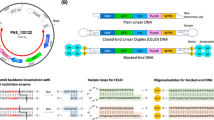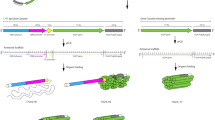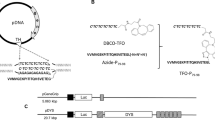Abstract
We prepared a series of linearized DNA duplexes of various lengths in order to examine the effects of topology and the size of exogenous, plasmid-derived DNAs on transgene expression. These linearized DNA duplexes were capped at each end with a highly stable loop (5’-GCGAAGC-3’) to produce a dumbbell-shaped construct that is refractory to exonuclease digestion in comparison to the analogous uncapped DNA duplexes. Intranuclear microinjection of the DNA dumbbells into simian COS-7 cells allowed the expression of the green fluorescent protein (GFP) gene on the linearized molecules, which was expressed five- to 10-fold more than that on the circular DNA of the same size. In addition, the expression by the dumbbell DNA was higher than that by the circular plasmid for at least 14 days. Interestingly, the size of the dumbbell DNA affected the transgene expression upon their microinjection into cell nuclei. The GFP expression efficiency increased with decreasing DNA size below a DNA size of 5.7 kb. The effects of topology and size on the expression of DNAs transfected with cationic lipids are similar to those of DNAs microinjected into cell nuclei. In contrast, microinjection into the cytosol showed the inverse size dependency over a range of 2.3 to 9.4 kb. Thus, transcription of a transgene in the nucleus, but not endocytosis or nuclear entry, was influenced by the exogenous DNA structure, and this was the primary determinant of transgene expression upon transfection under our conditions. These results indicate that small, linearized DNA duplexes that are end-capped with a highly stable loop (dumbbell-shaped DNA) would be very useful for nonviral gene therapy.
This is a preview of subscription content, access via your institution
Access options
Subscribe to this journal
Receive 12 print issues and online access
$259.00 per year
only $21.58 per issue
Buy this article
- Purchase on Springer Link
- Instant access to full article PDF
Prices may be subject to local taxes which are calculated during checkout






Similar content being viewed by others
References
Rolland AP . From genes to gene medicines: recent advances in nonviral gene delivery Crit Rev Ther Drug Carrier Syst 1998 15: 143–198
Gao X, Huang L . Potentiation of cationic liposome-mediated gene delivery by polycations Biochemistry 1996 35: 1027–1036
Simoes S et al. Gene delivery by negatively charged ternary complexes of DNA, cationic lipsomes and transferrin or fusigenic peptides Gene Therapy 1998 5: 955–964
Liang E, Hughes J . Characterization of a pH-sensitive surfactant, dodecyl-2-(1’-imidazolyl) propionate (DIP), and preliminary studies in liposome mediated gene transfer Biochim Biophys Acta 1998 1369: 39–50
Schoen P et al. Gene transfer mediated by fusion protein hemagglutinin reconstituted in cationic lipid vesicles Gene Therapy 1999 6: 823–832
Zanta MA, Belguise-Valladier P . Behr J-P. Gene delivery: a single nuclear localization signal peptide is sufficient to carry DNA to the cell nucleus Proc Natl Acad Sci USA 1999 96: 91–96
Kreiss P et al. Plasmid DNA size does not affect the physicochemical properties of lipoplexes but modulates gene transfer efficiency Nucleic Acids Res 1999 27: 3792–3798
Schakowski F et al. A novel minimal-size vector (MIDGE) improves transgene expression in colon carcinoma cells and avoids transfection of undesired DNA Mol Ther 2001 5: 793–800
Darquet A et al. Minicircle: an improved DNA molecule for in vitro and in vivo gene transfer Gene Therapy 1999 6: 209–218
Hirao I et al. Stability difference between DNA and RNA mini-hairpins containing two G-C pairs Nucleic Acids Symp Ser 1992 27: 127–128
Yoshizawa S et al. GNA trinucleotide loop sequences producing extraordinarily stable DNA minihairpins Biochemistry 1997 36: 4761–4767
Deniss IS, Morgan AR . Studies on the mechanism of DNA cleavage by ethidium Nucleic Acids Res 1976 3: 315–323
Krishnamurthy G, Polte T, Rooney T . Hogan ME A photochemical method to map ethidium bromide binding sites on DNA: application to a bent DNA fragment Biochemistry 1990 29: 981–988
Claycamp HG . Phenol sensitization of DNA to subsequent oxidative damage in 8-hydroxyguanine assays Carcinogenesis 1992 13: 1289–1292
Helbock HJ et al. DNA oxidation matters: the HPLC-electrochemical detection assay of 8-oxo-deoxyguanosine and 8-oxo-guanine Proc Natl Acad Sci USA 1998 95: 288–293
Douki T, Cadet J . Individual determination of the yield of the main UV-induced dimeric pyrimidine photoproducts in DNA suggests a high mutagenicity of CC photolesions Biochemistry 2001 40: 2495–2501
Grundemann D, Schomig E . Protection of DNA during preparative agarose gel electrophoresis against damage induced by ultraviolet light Biotechniques 1996 21: 898–903
Liu J, Doetsch PW . Escherichia coli RNA and DNA polymerase bypass of dihydrouracil: mutagenic potential via transcription and replication Nucleic Acids Res 1998 26: 1707–1712
Viswanathan A, Doetsch PW . Effects of nonbulky DNA base damages on Escherichia coli RNA polymerase-mediated elongation and promoter clearance J Biol Chem 1998 273: 21276–21281
Selby CP, Drapkin R, Reinberg D, Sancar A . DNA excision repair Nucleic Acids Res 1997 25: 787–793
Sancar A . DNA excision repair Annu Rev Biochem 1996 65: 43–81
Wallace SS . Enzymatic processing of radiation-induced free radical damage in DNA Radiat Res 1998 150: S60–S79
Kamiya H et al. c-Ha-ras containing-hydroxyguanine at codon 12 induces point mutations at the modified and adjacent positions Cancer Res 1992 52: 3483–3485
Kamiya H et al. 8-Hydroxyguanine (7,8-dihydro-8-oxoguanine) in hot spots of the c-Ha-ras gene. Effects of sequence contexts on mutation spectra Carcinogenesis 1995 16: 883–889
Kamiya H et al. 8-Hydroxyadenine (7, 8-dihydro-8-oxoadenine) induces misincorporation in in vitro DNA synthesis and mutations in NIH3T3 cells Nucleic Acids Res 1995 23: 2893–2899
Kamiya H, Kasai H . Mutations induced by 2-hydroxyadenine on a shuttle vector during leading and lagging strand syntheses in mammalian cells Biochemistry 1997 36: 11125–11130
Kamiya H, Kasai H . Mutations induced by 2-hydroxyadenine on a shuttle vector during leading and lagging strand syntheses in mammalian cells Sambrook J, Fritsch EF, Maniatis T. (1989) Molecular Cloning: A Laboratory Manual, 2nd edn. Cold Spring Harbor Laboratory Press: Cold Spring Harbor, pp 6.30–6.31.
Acknowledgements
We thank Dr Hirotake Kitaura of Hokkaido University, for his technical advice. We are grateful to Dr Paul T Henderson of MIT for reading the manuscript. This work was supported in part by Grants-in-Aid for Scientific Research on Priority Areas from the Ministry of Education, Culture, Sports, Science, and Technology of Japan.
Author information
Authors and Affiliations
Rights and permissions
About this article
Cite this article
Kamiya, H., Yamazaki, J. & Harashima, H. Size and topology of exogenous DNA as determinant factors of transgene transcription in mammalian cells. Gene Ther 9, 1500–1507 (2002). https://doi.org/10.1038/sj.gt.3301831
Received:
Accepted:
Published:
Issue Date:
DOI: https://doi.org/10.1038/sj.gt.3301831
Keywords
This article is cited by
-
A Novel Terminator Primer and Enhancer Reagents for Direct Expression of PCR-Amplified Genes in Mammalian Cells
Molecular Biotechnology (2015)



